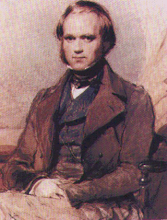
In discounting land bridges as a means of species dispersal,
Always the experimentalist, Darwin soaked seeds in salt water to determine how long they could be immersed and still sprout. In one set of experiments he used 87 kinds of seeds, 64 of which germinated after 28 days of immersion; a few survived 137 days—surely time enough for a hypothetical seed to float from a continent to an island. In other experiments he tested the viability of seeds found in the gizzard or crop of birds, and looked for seeds adhering to birds’ feet as two other possible ways to transport seeds. Research since
Darwin's last publication, a note published in the British journal Nature on April 6, 1882, (two weeks before his death) was on the chance dispersal of a freshwater clam attached to a beetle's leg. Darwin learned of this specimen from "Mr. W.D. Crick of Northampton"....grandfather of Francis Crick, a co-discoverer of the structure of the DNA molecule 71 years later.
Photo credit: http://www.wsq.org.au/heterotheca_grandiflora40.JPG


No comments:
Post a Comment